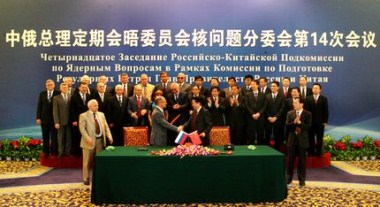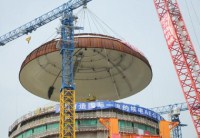Further cooperation for China and Russia
02 September 2010

Cooperation between China and Russia is to expand to cover floating nuclear power plants.
The news came in an announcement of the results of the annual meeting of the country's state nuclear companies. Head of Rosatom Sergei Kiriyenko travelled to Beijing for the meeting that he co-chaired with Chen Quifa, chair of the China Atomic Energy Authority.
The 13th such annual meeting, the dignitaries summarised their work together and agreed to expand their joint programs. Listed for the first time were floating nuclear power plants alongside other technical areas such as space reactors and isotope heat sources, also for use in space.
New build update
 Yangjiang 1 Yangjiang 1
The construction of new nuclear plants in China has continued with the lifting into place of the containment domes of two reactors.
Yangjiang 1's dome was put in place on 30 August. Work on the CPR-1000 unit was started in January 2008 by China Guangdong Nuclear Power Company. The same operation took place at Fuqing 1, also a CPR-1000, on 18 August.
Meanwhile in Russia, the first parts of the core catcher of Novovoronezh Phase II unit 2 have been put in place. Concreting work continues on main structures within the reactor building and the supporting collonade of the cooling tower is in place. The cooling tower main structure will be built "in the near future," Rosatom said. |
General topics for the nations were decommissioning of nuclear power plants, expansion into third-country markets, emergency preparedness and uranium exploration. Some 60 leaders from firms and government bodies in both countries attended the meeting.
The first floating nuclear power plant, the Academician Lomonosov, is under construction at Saint Petersburg. The vessel for the plant was launched in July, while the components of the reactors and power system remain to be fitted. It will be towed to Vilyuchinsk in Russia's far east to serve the remote town's energy needs.
The two reactors on board will be KLT-40S units similar to those used in Russia's nuclear-powered naval and icebreaker fleets. China already operates nuclear-powered naval vessels and is considered the leading candidate to return nuclear power to civil fleets, where it has all but died out. Russia's icebreakers are the only example of civil nuclear power at sea, but concerns over greenhouse gas emissions have revived interest in specialist nuclear-powered vessels, for example to carry mineral ore in bulk.
Researched and written
by World Nuclear News